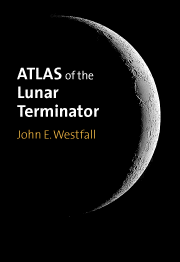Book contents
- Frontmatter
- Contents
- Preface and Acknowledgements
- dedication
- Section I Terminator Observation and Interpretation
- Chapter 1 Observing the Moon and Its Terminator
- Chapter 2 The Moon's Surface Features
- Section II Atlas
- Appendix: Lunar Physical Ephemeris, 2000-2010
- Bibliography
- Mosaic Feature Index
- Subject Index
- Individual Features Index
Chapter 1 - Observing the Moon and Its Terminator
Lunar Visibility Factors
from Section I - Terminator Observation and Interpretation
Published online by Cambridge University Press: 05 February 2015
- Frontmatter
- Contents
- Preface and Acknowledgements
- dedication
- Section I Terminator Observation and Interpretation
- Chapter 1 Observing the Moon and Its Terminator
- Chapter 2 The Moon's Surface Features
- Section II Atlas
- Appendix: Lunar Physical Ephemeris, 2000-2010
- Bibliography
- Mosaic Feature Index
- Subject Index
- Individual Features Index
Summary
The Moon's Changing Lighting
A line encircles the Moon and rotates about it every 29.5 Earth days, moving westward along the equator at a leisurely 15 kilometers per hour. It has circled the Moon tens of thousands of millions of times in the past and should continue to do so at least as many times in the future. This line is called the terminator, and is defined as the great circle where the Sun is on the local horizon at any particular time. One half of the terminator marks lunar sunrise, moving so as to expose more and more of the Moon's surface to sunlight. The other half of the line defines where the Sun is setting, where areas become gradually engulfed by the lunar night. The area of the terminator is of prime interest because its glancing illumination highlights subtle, low-lying relief features.
The movement of the terminator from one night to the next is obvious even when viewing the Moon with the naked eye. In the telescope, the changing lighting conditions are apparent in a matter of hours, and near the terminator itself in minutes, as is shown in the time sequence of CCD frames in Figure 1.1 (page 2).
There are several ways that the lighting conditions of the Moon can be described for any particular time. The first three are approximate; phase, age, and proportion illuminated. Phase simply describes lighting with the approximate phrase: New Moon, Waxing Crescent, First Quarter, Waxing Gibbous, Full Moon, Waning Gibbous, Last (or Third) Quarter, and Waning Crescent.
- Type
- Chapter
- Information
- Atlas of the Lunar Terminator , pp. 1 - 25Publisher: Cambridge University PressPrint publication year: 2000



